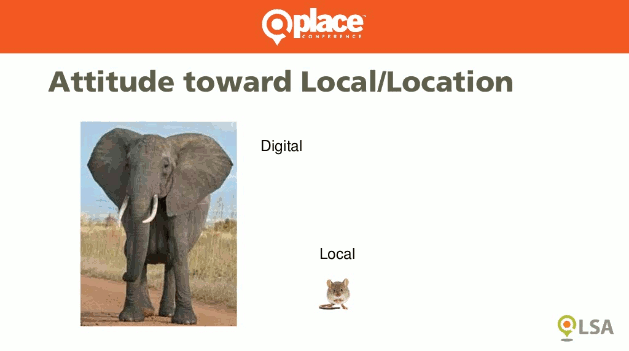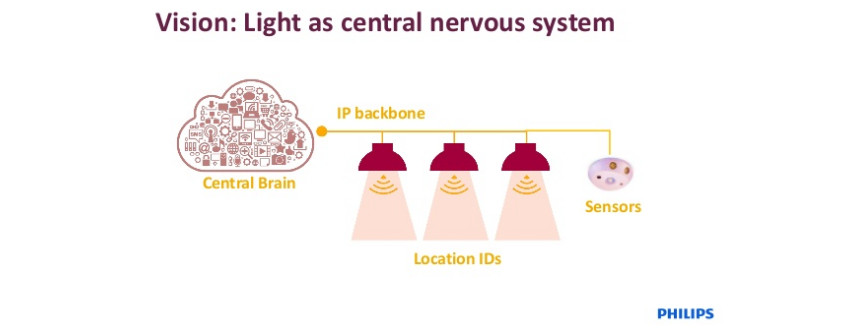The 2016 Place Conference brought together the brands, retailers, agencies and technology companies pushing the envelope of cross-platform proximity marketing, indoor experiences and location analytics. We feel that organiser Greg Sterling of The LSA, in his introduction, most eloquently summarised in two slides why local matters:

While we spend an increasing amount of time online, we still spend the majority of our money locally, close to work and home. The following is a brief summary of our takeaways from the conference.
Still educating, still adopting
“How many people here have had a real-world beacon experience?”
In a room of a hundred, a mere handful of hands were raised. This hammered home the point that although proximity experiences currently receive all the attention, the reality is that three years after the launch of the iBeacon with iOS 7, and with over 8 million proximity sensors deployed globally today according to Proxbook, the concept is still in its infancy. Instead, it was the presentations on location analytics, a less-glamorous subject, which boasted tangible, measurable results.
Erin Kienast of OMD, who successfully ran such a campaign with McDonald’s, said she spends a lot of time educating local media agencies about the power of location, and how they can use the data. Our experience has been the same. Indeed, while the national agencies may have the edge in education, the local agencies still outweigh them in terms of volume. Education precedes adoption, and a few turnkey solutions certainly wouldn’t hurt either.
We’re not making it easy
“We’re making it really hard for the CMO today” said Pehr Luedtke of Vanassis. “How do the CMOs understand the crazy landscape of location tech?”
Greg Sterling affirmed, “technology companies add complexity beyond what a human operator can be expected to handle.” We know. As a technology company, we’re as guilty of that as any of our peers that were in the room, but we’re working hard to improve. Our approach has been to approach retailers within a partner ecosystem where we master the location technology and our partners individually master the experience, marketing communications, change management, analytics and such. Technology companies should leave end-user-interaction to the experts.
New channel, new offer
“You can’t push the same offer through a digital channel” said Jay Hawkinson of SIM Partners. “You need to make a compelling location-based offer.”
Indeed it doesn’t make sense to make all the effort to meet the customer where they are, only then to serve them up a generic offer. But it certainly does take additional consideration to create the most relevant offer, and marketers need to be prepared. In our retail deployment experience, the impact of even a modestly tailored offer versus a generic offer was orders of magnitude greater. But our partners still had to push to make it happen!
Location accuracy: who cares?
Google doesn’t. Aisle411 does.

One can argue that they’re both right. In the case of absolute location, the traditional latitude-longitude measurement, accuracy dictates granularity. And for Aisle411, 30cm is the right granularity. However, in the case of semantic location, championed by both Google and ourselves, all that really matters is what’s nearby to the user. In other words it’s simply relative.
A light bulb just went off
“How many advertisers does it take to change a [connected] LED light bulb?” joked Google’s Frank van Diggelen.

Both Philips and Acuity shed light (pun intended) on the fact that one thing is for sure indoors: we’re always near a light. Internet-connected LED lighting overcomes the three challenges faced by location technology:
- persistent power
- consistent connectivity
- necessity of infrastructure
The combination of smartphones and connected lighting promises accurate location via beacons, WiFi, computer vision, magnetics, inertial and visible light communication (VLC). Curiously excluded from the list, however, was Bluetooth as a real-time location system (RTLS), essentially beacons in reverse.
Are people beacons too?
If smartphones act as beacons (as many wearables already do), then connected lighting could identify and locate the people carrying them. We first demonstrated the concept three years ago, using our own connected sensor infrastructure. Last week, to celebrate that anniversary, we proclaimed that The Physical Web just got Personal.
“Can people be considered places? In other words, can a person’s smartphone act as a beacon?” we asked Chandu Thota, Director of Engineering at Google. The answer, as we expected, was no, that’s not how Google sees it. Thota confirmed that we were not alone in advancing applications where the smartphone “advertises” itself to its surroundings. But the company behind Android, Eddystone and The Physical Web (at least) currently sees the smartphone exclusively as a receiver of what is nearby to its user.
Is the industry abusively smartphone-centric?
The smartphone is an incredible innovation which has revolutionised how brands can interact with their customers. Nonetheless, it is easy to argue, as one attendee did, that imagining those customers walking through stores with their eyes glued to their smartphones is downright dangerous! Case in point, this video.

What we’ve heard from brick-and-mortar retailers is that they want to emphasise the human experience of shopping, aided by the tools pioneered by online retailers. For us, the smartphone-centric approach is at odds with that vision, instead emphasising the digital experience within a physical context.
Our hope for the next Place Conference is to see case studies of CMO-friendly end-to-end solutions which deliver delightful experiences with tangible results all the while keeping the smartphone in the users pocket to the extent possible. See you there!
Comments
2 responses to “Proximity in its Place”
[…] However, from Android 5 onwards, like in iOS, periodically-changing identifiers are employed. At the Place Conference, we asked Chandu Thota, Director of Engineering at Google, what one thing he’d like to see […]
LikeLike
[…] in-store experience is what brick-and-mortar retail is all about, and we were (again) reminded that 9 out of 10 purchases are still made in-store. But without a unified customer view, […]
LikeLike